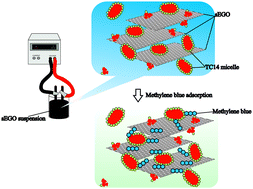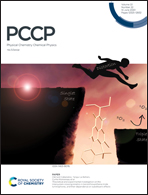Highly branched triple-chain surfactant-mediated electrochemical exfoliation of graphite to obtain graphene oxide: colloidal behaviour and application in water treatment†
Abstract
The generation of surfactant-assisted exfoliated graphene oxide (sEGO) by electrochemical exfoliation is influenced by the presence of surfactants, and in particular the hydrophobic tail molecular-architecture. Increasing surfactant chain branching may improve the affinity for the graphite surfaces to provide enhanced intersheet separation and stabilisation of exfoliated sheets. The resulting sEGO composites can be readily used to remove of a model pollutant, the dye, methylene blue (MB), from aqueous solutions by providing abundant sites for dye adsorption. This article explores relationships between surfactant structure and the performance of sEGO for MB adsorption. Double-branched and highly branched triple-chain graphene-compatible surfactants were successfully synthesised and characterised by 1H NMR spectroscopy. These surfactants were used to produce sEGO via electrochemical exfoliation of graphite, and the sEGOs generated were further utilised in batch adsorption studies of MB from aqueous solutions. The properties of these synthesised surfactants were compared with those of a common single-chain standard surfactant, sodium dodecyl-sulfate (SDS). The structural morphology of sEGO was assessed using Raman spectroscopy and field emission scanning electron microscopy (FESEM). To reveal the links between the hydrophobic chain structure and the sEGO adsorption capacity, UV-visible spectroscopy, zeta potential, and air–water (a/w) surface tension measurements were conducted. The aggregation behaviour of the surfactants was studied using small-angle neutron scattering (SANS). The highly branched triple-chain surfactant sodium 1,4-bis(neopentyloxy)-3-(neopentylcarbonyl)-1,4-dioxobutane-2-sulfonate (TC14) displayed enhanced exfoliating efficiency compared to those of the single-and double-chain surfactants, leading to ∼83% MB removal. The findings suggest that highly branched triple-chain surfactants are able to offer more adsorption sites, by expanding the sEGO interlayer gap for MB adsorption, compared to standard single-chain surfactants.



 Please wait while we load your content...
Please wait while we load your content...